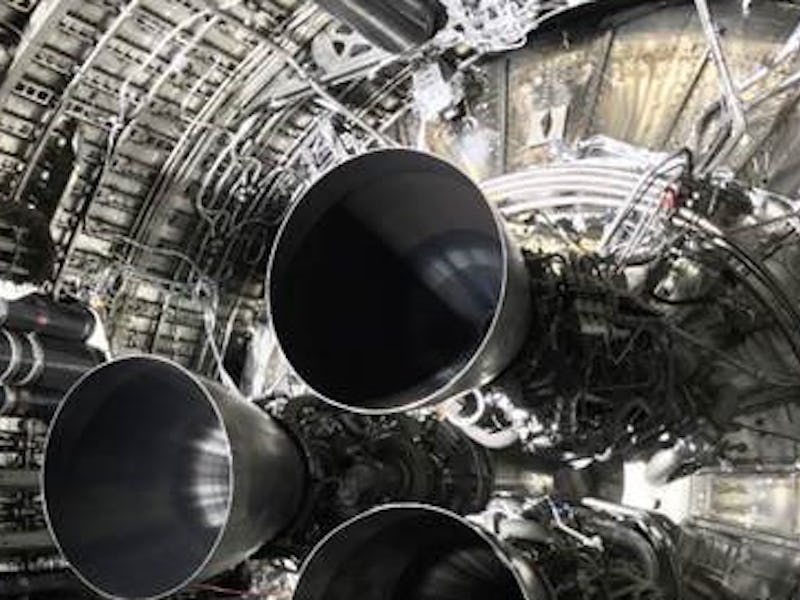SpaceX Starship: incredible image shows 3 Raptor engines taking shape
SpaceX CEO Elon Musk shared a photo that shows just how far the company has come in terms of preparation for its upcoming tests.

The Starship, SpaceX's Mars-bound spaceship, is taking on a big challenge — and Elon Musk has given a preview of how it's going to work.
On Wednesday, the CEO shared an image of the underside of Starship "SN8," a prototype model of the ship designed to send humans to Mars and beyond. This model, packed with three Raptor engines, is expected to fly to the highest altitude yet. While previous prototypes have reached up to 150 meters, or 500 feet, in altitude during "hop tests," SN8 is expected to reach 15 kilometers, or around 50,000 feet.
The test could pave the way for Starship's most ambitious missions. The stainless steel ship is designed to support similar missions to the Falcon 9 and Falcon Heavy. It's also a fully-reusable ship that can send up to 150 tons or 100 people into space at a time. Its use of liquid oxygen and methane propellant means astronauts can fly to Mars, use the planet's resources to refuel, and either return home or venture out further.
"Will be less roomy with 3 vacuum rocket engines added," Musk wrote on Twitter Wednesday. Previous prototypes have used a single Raptor engine designed for use at sea level. The "SN8" shown in the picture packs three sea-level engines in a triangular configuration.
The final version is expected to feature those three engines, plus three larger Raptors designed for use in the vacuum of space.
SN8 with its engines.
The ship, which measures 30 feet wide and 160 feet tall, will pair with the Super Heavy booster to help it leave the Earth. This will make the ship stand around 400 feet tall. The booster is expected to pack a staggering 28 Raptor engines.
A successful test for SN8 could mean the ship can continue on to more ambitious flights, like an orbital launch. The prototype has been coming together at speed:
- On August 11, when unveiling the fully-completed "SN6" model, Musk revealed that "SN7" would be a test tank while SN8 would be more spaceship-looking with flaps and nosecone.
- On August 18, Musk confirmed the team was building SN8.
- On September 12, Musk stated SN8 should be "done in about a week."
- On September 26, Musk shared a photo of the prototype complete with motor-driven rear body flaps. He also stated the firm would add the nosecone and front flaps the following week.
- On October 9, Musk reported that SN8 had passed a cryo proof test. This tests the ship's ability to handle the super-cold fuel and pressures it'll experience in spaceflight.
- NASASpaceflight reported on October 11 that SpaceX had started installing the three Raptor engines that day.
From here, the ship is expected to undergo a series of tests. This, Musk outlined in September, would involve completing a static test fire of the triple-engined machine. The team would then complete checkouts, a second static fire, and finally the flight itself.
The Inverse analysis – SN8's flight could be one of the most impressive in terms of visual spectacle alone. It will be the first time that SpaceX has flown a full-size Starship with body flaps, nosecone, and the expected triple-Raptor formation. A little less farm silo, a little more flying spaceship.
SpaceX will still need to tackle the orbital launch. At the September 2019 event, Musk claimed this would take place in a matter of months. SpaceX is likely to reveal more about this goal, and other details, at the event expected later this month.
THE STARSHIP’S JOURNEY, SUMMARIZED
- November 2018 – BFR, first announced in September 2017, gets renamed toStarship.
- December 2018 – Musk confirms the new ship has switched to stainless steel.
- January 2019 – Shortened “Starhopper” prototype unveiled and Musk explains the switch to steel.
- February 2019 – Raptor engine beats a long-standing rocket record.
- April 2019 – Starhopper completes a tethered “hop.”
- July 2019 – Starhopper launches 20 meters (67 feet).
- August 2019 – Starhopper launches 150 meters (500 feet).
- September 2019 – Starship Mk.1 full-size prototype unveiled.
- May 2020 – Starship SN4 full-size prototype completes a static test fire.
- August 2020 – Starship SN5 launches 150 meters (500 feet).